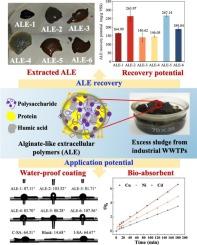从工业活性污泥中回收海藻酸盐样胞外聚合物:特性和应用潜力
IF 6.7
2区 工程技术
Q1 ENGINEERING, CHEMICAL
引用次数: 0
摘要
从污水处理厂(WWTPs)产生的多余污泥中回收海藻酸盐样细胞外聚合物(ALEs)已经引起了相当大的关注,因为它们为实现循环经济提供了可持续的战略。然而,从工业污水处理厂的活性污泥中回收ALEs的前景仍有待阐明。研究了从工业剩余污泥中提取ALEs的产率、理化性质及应用前景。结果表明,ALE的产率为140 ~ 267 mg/g·VSS,提取的ALE的海藻酸盐当量为29% ~ 48%。通过将ale与CaCl2交联,可以立即形成Ca2+-ALE水凝胶,表明其具有高离子凝胶形成性能。傅里叶变换红外(FTIR)和拉曼光谱分析表明,ALE具有丰富的与蛋白质和多糖相关的官能团,与商业海藻酸盐的官能团相似性为40% ~ 61%。电感耦合等离子体发射光谱(ICP-OES)元素分析表明,提取的ALEs中重金属含量较低,具有较好的应用前景。根据其成膜性能、两亲性和疏水性,提取的ALEs可作为防水表面涂层。此外,ALEs水凝胶珠对Cd2+和Cu2+的吸附能力分别为132.31±0.40 mg/g和71.85±0.40 mg/g,与商业海藻酸盐凝胶珠相当。本研究扩大了我们对ALEs生物材料从工业剩余污泥中回收和应用的认识。本文章由计算机程序翻译,如有差异,请以英文原文为准。

Alginate-like extracellular polymers recovery from industrial activated sludge: characteristics and application potential
Alginate-like extracellular polymers (ALEs) recovery from excess sludge produced in wastewater treatment plants (WWTPs) has drawn considerable attention as they offer a sustainable strategy for achieving a circular economy. However, the prospect of ALEs recovery from activated sludge of industrial WWTPs remains to be elucidated. In this study, the yields, physicochemical properties and potential applications of ALEs from industrial excess sludge were investigated. The results showed that ALEs' yields were ranged from 140 to 267 mg/g·VSS, and the alginate equivalents of the extracted ALE were 29 %–48 %. Ca2+-ALE hydrogels were immediately formed by cross-linking ALEs with CaCl2, suggesting their high ionic gel-forming property. Fourier Transform Infrared (FTIR) and Raman spectral analyses showed that ALE possessed abundant functional groups related to protein and polysaccharide, and the similarities of functional groups between ALEs and commercial alginate were 40 %–61 %. Elemental analysis using Inductively Coupled Plasma Optical Emission Spectroscopy (ICP-OES) revealed that the extracted ALEs possessed relatively low concentrations of heavy metals, which ensured its potential application. Based on the film-forming property, amphiphilicity and hydrophobicity, the extracted ALEs could be applied as a water-proof surface coating. Additionally, the ALEs hydrogel beads showed great absorption capacities for Cd2+ and Cu2+, being 132.31 ± 0.40 mg/g and 71.85 ± 0.40 mg/g, respectively, which were comparable to those of commercial alginate-based gel beads. This study expands our understanding of the ALEs biomaterials recovery and applications from industrial excess sludge.
求助全文
通过发布文献求助,成功后即可免费获取论文全文。
去求助
来源期刊

Journal of water process engineering
Biochemistry, Genetics and Molecular Biology-Biotechnology
CiteScore
10.70
自引率
8.60%
发文量
846
审稿时长
24 days
期刊介绍:
The Journal of Water Process Engineering aims to publish refereed, high-quality research papers with significant novelty and impact in all areas of the engineering of water and wastewater processing . Papers on advanced and novel treatment processes and technologies are particularly welcome. The Journal considers papers in areas such as nanotechnology and biotechnology applications in water, novel oxidation and separation processes, membrane processes (except those for desalination) , catalytic processes for the removal of water contaminants, sustainable processes, water reuse and recycling, water use and wastewater minimization, integrated/hybrid technology, process modeling of water treatment and novel treatment processes. Submissions on the subject of adsorbents, including standard measurements of adsorption kinetics and equilibrium will only be considered if there is a genuine case for novelty and contribution, for example highly novel, sustainable adsorbents and their use: papers on activated carbon-type materials derived from natural matter, or surfactant-modified clays and related minerals, would not fulfil this criterion. The Journal particularly welcomes contributions involving environmentally, economically and socially sustainable technology for water treatment, including those which are energy-efficient, with minimal or no chemical consumption, and capable of water recycling and reuse that minimizes the direct disposal of wastewater to the aquatic environment. Papers that describe novel ideas for solving issues related to water quality and availability are also welcome, as are those that show the transfer of techniques from other disciplines. The Journal will consider papers dealing with processes for various water matrices including drinking water (except desalination), domestic, urban and industrial wastewaters, in addition to their residues. It is expected that the journal will be of particular relevance to chemical and process engineers working in the field. The Journal welcomes Full Text papers, Short Communications, State-of-the-Art Reviews and Letters to Editors and Case Studies
 求助内容:
求助内容: 应助结果提醒方式:
应助结果提醒方式:


